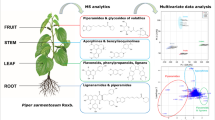Abstract
In this work, the metabolite profiles of ginsenosides Rk3 and Rh4 from steamed notoginseng in zebrafish were qualitatively investigated, and their possible metabolic pathways were subsequently proposed. Metabolites of ginsenosides Rk3 and Rh4 after exposing to zebrafish for 24 h were identified by Ultraperformance Liquid Chromatography/Quadrupole -Time-of-Flight Mass Spectrometry (UPLC-TOF/MS). The separation was performed with a UPLC BEH C18 column using a binary gradient elution of 0.1 % formic acetonitrile −0.1 % formic acid water. The quasi-molecular ions of compounds were detected in negative mode. According to the quasi-molecular ions and MS2 spectra, after comparison with reference standards, molecular mass information and the potential structures about metabolites of ginsenosides Rk3 and Rh4 were obtained. In all, 5 and 6 metabolites of ginsenoside Rk3 and Rh4 including M1(M6), M2(M7), M3–M5 and N1, N2(N7), N3–N6 were identified in zebrafish respectively, which were to our knowledge reported for the first time. The results indicated that ginsenosides Rk3 and Rh4 were metabolized via desugarization, glucuronidation, sulfation, dehydroxylation, and loss of C-17 and C-23 residue pathways in zebrafish. Loss of glucose at position C-6 and glucuronidation at position C-3 or C-6 in zebrafish were considered as the main physiologic processes of ginsenosides Rk3 and Rh4.




Similar content being viewed by others
References
Almeida, D.V., B.F. da Silva Nornberg, L.A. Geracitano, D.M. Barros, J.M. Monserrat, and L.F. Marins. 2010. Induction of phase II enzymes and hsp70 genes by copper sulfate through the electrophile-responsive element (EpRE): Insights obtained from a transgenic zebrafish model carrying an orthologous EpRE sequence of mammalian origin. Fish Physiology and Biochemistry 36: 347–353.
Baek, S.H., X.L. Piao, U.J. Lee, H.Y. Kim, and J.H. Park. 2006. Reduction of cisplatin-induced nephrotoxicity by ginsenosides isolated from processed ginseng in cultured renal tubular cells. Biological &/and Pharmaceutical Bulletin 29: 2051–2055.
Bresolin, T., M. de Freitas Rebelo, and A. Celso Dias Bainy. 2005. Expression of PXR, CYP3A and MDR1 genes in liver of zebrafish. Comparative Biochemistry and Physiology Part C: Toxicology & Pharmacology 140: 403–407.
Chan, E.C.Y., S.L. Yap, A.J. Lau, P.C. Leow, D.F. Toh, and H.L. Koh. 2007. Ultra-performance liquid chromatography/time-of-flight mass spectrometry based metabolomics of raw and steamed Panax notoginseng. Rapid Communications in Mass Spectrometry 21: 519–528.
Chen, B., T. Cai, and X.B. Jia. 2014. Simultaneous determination of ten active ginsenosides in steamed notoginseng by UPLC. China Journal of Chinese Materia Medica 39: 22–27.
Chen, Q.X., and S. Zeng. 2011. Research progress of zebrafish used in drug metabolism. Acta Pharmaceutica Sinica 46: 1026–1031.
Dong, T.X., X.M. Cui, Z.H. Song, K.J. Zhao, Z.N. Ji, C.K. Lo, and K.W. Tsim. 2003. Chemical assessment of roots of Panax notoginseng in China regional and seasonal variations in its active constituents. Journal of Agriculture and Food Chemistry 51: 4617–4623.
Goldsmith, P. 2004. Zebrafish as a pharmacological tool: the how, why and when. Current Opinion in Pharmacology 4: 504–512.
Kitambi, S.S., E.S. Nilsson, P. Sekyrova, C. Ibarra, G.N. Tekeoh, M. Andäng, P. Ernfors, and P. Uhlén. 2012. Small molecule screening platform for assessment of cardiovascular toxicity on adult zebrafish heart. BMC Physiology 12: 3–9.
Lee, J.G., Y.Y. Lee, B. Wu, S.Y. Kim, Y.J. Lee, H.S. Yun-Choi, and J.H. Park. 2010. Inhibitory activity of ginsenosides isolated from processed ginseng on platelet aggregation. Pharmazie 65: 520–522.
Liang, A. 2009. Zebrafish–useful model for pharmacodynamics and toxicity screening of traditional Chinese medicine. China Journal of Chinese Materia Medica 34: 2839–2842.
Lü, A.J., Z.X. Yang, and H.R. Liu. 2010. Isolation of intestinal bacteria from zebrafish (Danio rerio) and their physiological and biochemical characteristics. Chinese Agricultural Science Bulletin 26: 412–415.
Sukardi, H., H.T. Chng, E.C. Chan, Z. Gong, and S.H. Lam. 2011. Zebrafish for drug toxicity screening: Bridging the in vitro cell-based models and in vivo mammalian models. Expert Opinion on Drug Metabolism & Toxicology 7: 579–589.
Sun, H., Y. Ye, and Y. Pan. 2005. Immunological-adjuvant saponins from the roots of Panax notoginseng. Chemistry & Biodiversity 2: 510–515.
Thompson, E.D., K.E. Burwinkel, E.G. Notch, A.K. Chava, and G.D. Mayer. 2010. Activity of Phase I and Phase II enzymes of the benzopyrene transformation pathway in zebrafish following waterborne exposure to arsenite. Comparative Biochemistry and Physiology Part C: Toxicology & Pharmacology 152: 371–378.
Toh, D.F., L.S. New, H.L. Koh, and E.C.Y. Chan. 2010. Ultra-high performance liquid chromatography/time-of-flight mass spectrometry (UHPLC/TOFMS) for time-dependent profiling of raw and steamed Panax notoginseng. Journal of Pharmaceutical and Biomedical Analysis 52: 43–50.
Wang, D., P.Y. Liao, H.T. Zhu, K.K. Chen, M. Xu, Y.J. Zhang, and C.R. Yang. 2012. The processing of Panax notoginseng and the transformation of its saponin components. Food Chemistry 132: 1808–1813.
Wei, Y.J., X.B. Jia, Y. Zhan, C.M. Wang, and B. Chen. 2013a. Metabolism Study of Chrysin by Zebrafish. Chinese Pharmaceutical Journal 48: 565–568.
Wei, Y.J., C.M. Wang, Y. Zhan, B. Chen, E. Sun, and X.B. Jia. 2013b. Reasonability of 7-hydroxyflavone metabolism in Zebrafish. Chinese Journal of New Drugs 22: 1078–1082.
Wei, Y.J., Y. Zhan, C.M. Wang, B. Chen, and X.B. Jia. 2013c. Metabolism of 5-hydroxyflavone in model organism zebrafish. Chinese JMAP 30: 461–465.
Acknowledgments
This work was supported by the Natural Science Foundation of China (nos. 81102812, and 30973978) and the Natural Science Foundation of Jiangsu province of China (BK2011866)
Conflict of interest
The authors declare no competing financial interest.
Author information
Authors and Affiliations
Corresponding author
Rights and permissions
About this article
Cite this article
Chen, B., Wei, Y., Wang, D. et al. Metabolism of ginsenosides Rk3 and Rh4 from steamed notoginseng in zebrafish by ultraperformance liquid chromatography/quadrupole-time-of-flight mass spectrometry. Arch. Pharm. Res. 38, 1468–1476 (2015). https://doi.org/10.1007/s12272-014-0538-7
Received:
Accepted:
Published:
Issue Date:
DOI: https://doi.org/10.1007/s12272-014-0538-7




